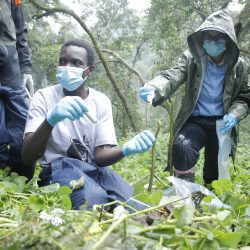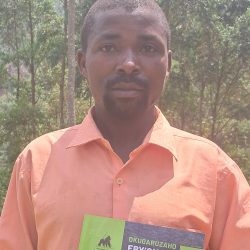Tracking the Twins – Part 2
Blog | 14/03/09
Here’s more on my experience tracking the Nkuringo gorilla group in Uganda, which I blogged about earlier.
As I emerge from the scrubby undergrowth of the Park-to-farm transitional forest I am startled by Mama Christmas, and older female who has broken from the pack and is sitting stoically on top of a huge boulder overlooking the squawking birds and bubbling streams of Bwindi below.
She seems to enjoy the wind, glancing around and up, and then casually tearing off a few leaves from a young bush creeping up the rock and stuffing them into her mouth. As I stop for a photo, she turns and jumps down towards me. I step aside as she heads down the hill to join the family, apparently satiated by the cool breeze and excellent view.
The wind is breaking small branches off of trees as I start the long trek up the mountain. My knees are happier though, and the sun is still bursting through the thin grey clouds.
Nkuringo Village’s residents were peacefully going about their business in the early morning when I left, the gorillas are doing well and even the gathering gale adds a strangely calming element to Bwindi’s countless peaks and valleys. It is the kind of morning that makes one fall in love with this very special place.
Still on my high in the afternoon, I pass the Park Warden, James Busiku, on a walk up to my favorite viewpoint, which affords a breathtaking panorama of all seven of the Virunga Volcanoes, the never ending expanse of the Great Rift Valley, Bwindi’s carpeted green slopes and, on a clear day, Uganda’s glacial Ruwenzoris – the “Mountains of the Moon.”
He tells me the story of the local alcohol, usually brewed with bananas, called Warangi. It originated in World War II, when the fight for Africa saw German and Italian troops invade the area. They needed their drink, and the locals concocted a brew which the soldiers dubbed “War Gin.” War Gin eventually morphed into “Warangi” in the local Bakiiga language.
“I don’t like Warangi, though,” says James. “It is cheap, easy to make and plentiful, and too many men in the villages here use it to stay drunk all day.” My balloon has been popped.
I am brought down to earth by this reminder that there is still much work to be done in our partnership with local communities, and though the Nkuringo gorillas are relatively safe, the communities with which they share their home still need respectful, sustainable development. Our collaboration must evolve alongside IGCP’s gorilla conservation efforts. As I take in the viewpoint, I know that Nkuringo’s natural beauty will always remain, but our work with both its forest and village inhabitants is only beginning.
This is a serious, long-term commitment.





